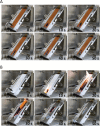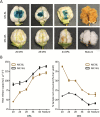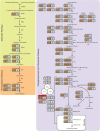The GhTT2_A07 gene is linked to the brown colour and natural flame retardancy phenotypes of Lc1 cotton (Gossypium hirsutum L.) fibres
- PMID: 27567364
- PMCID: PMC5049394
- DOI: 10.1093/jxb/erw312
The GhTT2_A07 gene is linked to the brown colour and natural flame retardancy phenotypes of Lc1 cotton (Gossypium hirsutum L.) fibres
Abstract
Some naturally coloured brown cotton fibres from accessions of Gossypium hirsutum L. can be used to make textiles with enhanced flame retardancy (FR). Several independent brown fibre loci have been identified and mapped to chromosomes, but the underlying genes have not yet been identified, and the mechanism of lint fibre FR is not yet fully understood. In this study, we show that both the brown colour and enhanced FR of the Lc1 lint colour locus are linked to a 1.4Mb inversion on chromosome A07 that is immediately upstream of a gene with similarity to Arabidopsis TRANSPARENT TESTA 2 (TT2). As a result of the alternative upstream sequence, the transcription factor GhTT2_A07 is highly up-regulated in developing fibres. In turn, genes in the phenylpropanoid metabolic pathway are activated, leading to biosynthesis of proanthocyanidins and accumulation of inorganic elements. We show that enhanced FR and anthocyanin precursors appear in developing brown fibres well before the brown colour is detectible, demonstrating for the first time that the polymerized proanthocyanidins that constitute the brown colour are not the source of enhanced FR. Identifying the particular colourless metabolite that provides Lc1 cotton with enhanced FR could help minimize the use of synthetic chemical flame retardant additives in textiles.
Keywords: Lc1 locus; brown fibre; cotton; fame retardant; flavonoid; proanthocyanidin; textiles; transparent testa..
© The Author 2016. Published by Oxford University Press on behalf of the Society for Experimental Biology.
Figures





Similar articles
-
Up-regulation of GhTT2-3A in cotton fibres during secondary wall thickening results in brown fibres with improved quality.Plant Biotechnol J. 2018 Oct;16(10):1735-1747. doi: 10.1111/pbi.12910. Epub 2018 Apr 2. Plant Biotechnol J. 2018. PMID: 29509985 Free PMC article.
-
Molecular analysis of proanthocyanidins related to pigmentation in brown cotton fibre (Gossypium hirsutum L.).J Exp Bot. 2014 Nov;65(20):5759-69. doi: 10.1093/jxb/eru286. Epub 2014 Aug 2. J Exp Bot. 2014. PMID: 25086591
-
Linkage and association mapping reveals the genetic basis of brown fibre (Gossypium hirsutum).Plant Biotechnol J. 2018 Feb 24;16(9):1654-66. doi: 10.1111/pbi.12902. Online ahead of print. Plant Biotechnol J. 2018. PMID: 29476651 Free PMC article.
-
Naturally colored cotton for wearable applications.Front Plant Sci. 2024 Mar 21;15:1350405. doi: 10.3389/fpls.2024.1350405. eCollection 2024. Front Plant Sci. 2024. PMID: 38576792 Free PMC article. Review.
-
Progress in Biodegradable Flame Retardant Nano-Biocomposites.Polymers (Basel). 2021 Feb 27;13(5):741. doi: 10.3390/polym13050741. Polymers (Basel). 2021. PMID: 33673607 Free PMC article. Review.
Cited by
-
Biochemical and Expression Analyses Revealed the Involvement of Proanthocyanidins and/or Their Derivatives in Fiber Pigmentation of Gossypium stocksii.Int J Mol Sci. 2022 Jan 17;23(2):1008. doi: 10.3390/ijms23021008. Int J Mol Sci. 2022. PMID: 35055193 Free PMC article.
-
Multi-omics analysis of pigmentation related to proanthocyanidin biosynthesis in brown cotton (Gossypium hirsutum L.).Front Plant Sci. 2024 Mar 13;15:1372232. doi: 10.3389/fpls.2024.1372232. eCollection 2024. Front Plant Sci. 2024. PMID: 38545383 Free PMC article.
-
Flame resistant cotton lines generated by synergistic epistasis in a MAGIC population.PLoS One. 2023 Jan 18;18(1):e0278696. doi: 10.1371/journal.pone.0278696. eCollection 2023. PLoS One. 2023. PMID: 36652412 Free PMC article.
-
A glutathione S-transferase GhTT19 determines flower petal pigmentation via regulating anthocyanin accumulation in cotton.Plant Biotechnol J. 2023 Feb;21(2):433-448. doi: 10.1111/pbi.13965. Epub 2022 Dec 12. Plant Biotechnol J. 2023. PMID: 36385569 Free PMC article.
-
Transcriptomic and Metabolomic Responses in Cotton Plant to Apolygus lucorum Infestation.Insects. 2022 Apr 15;13(4):391. doi: 10.3390/insects13040391. Insects. 2022. PMID: 35447833 Free PMC article.
References
-
- ASTM 2010. ASTM D1230-10. Standard test method for flammability of apparel textiles. West Conshohocken, PA, USA: ASTM International, http://www.astm.org.
-
- ASTM 2011. ASTM D5132-11. Standard test method for horizontal burning rate of polymeric materials used in occupant compartments of motor vehicles. West Conshohocken, PA, USA: ASTM International, http://www.astm.org.
-
- Bustin SA, Benes V, Garson JA, et al. 2009. The MIQE guidelines: minimum information for publication of quantitative realtime PCR experiments. Clinical Chemistry 55, 611–622. - PubMed
-
- Corradini E, Teixeira EM, Paladin PD, Agnelli JA, Silva ORRF, Mattoso LHC. 2009. Thermal stability and degradation kinetic study of white and colored cotton fibers by thermogravimetric analysis. Journal of Thermal Analysis and Calorimetry 97, 415–419.
-
- Culp TW, Moore RF, Harvey LH, Pitner JB. 1988. Registration of ‘PD-3’ cotton. Crop Science 28, 190.
MeSH terms
Substances
LinkOut - more resources
Full Text Sources
Other Literature Sources
Research Materials

